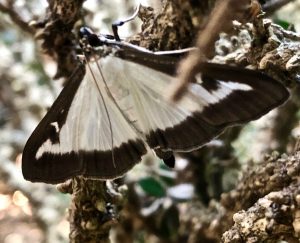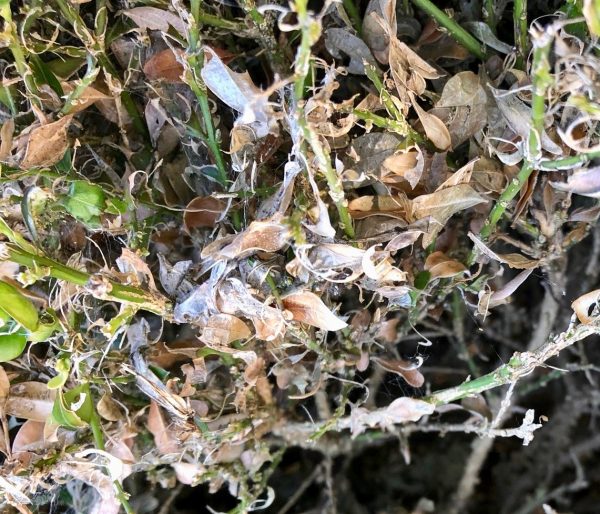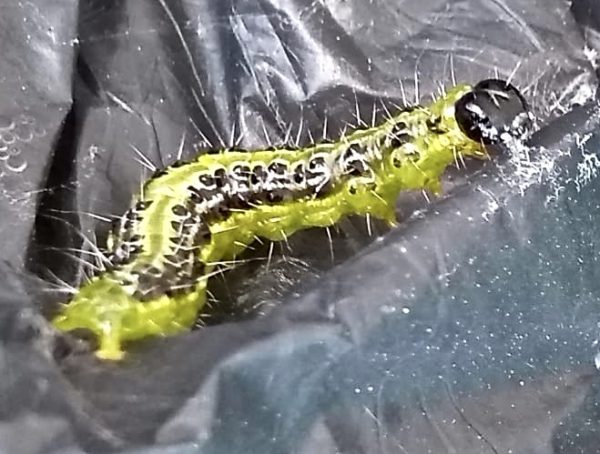The Box Moth – food, sex and death

The box moth has recently been ravaging the box hedges of Britain. Box hedges are like jam sandwiches to these hungry caterpillars and they are making gardens and woodlands unsightly and in some places they are putting at risk the survival of traditional hedging. Surprising as it may seem, there is an organisation dedicated to promoting boxwood - the European Boxwood and Topiary Society which celebrates and protects ornamental gardens across Europe.
Box Moths (Cydalima perspectalis) come in two forms - the common variant and the darker melanic variant. Like most animals, their main activities are eating and sex. The eating is mainly done by the caterpillars which eat the box leaves and create a trail of cobwebs and leaf pellets - part of an affected box bush is shown below :-

Part of a devastated Box Hedge
They come from eggs which have spent the winter wrapped in webbing between the leaves. The caterpillars come out in March when the weather warms up. These are truly "hungry caterpillars" so if you want to save your box hedges you need to swing into action with deadly intent.
There are three ways to kill these beasties:
- spray the leaves with a biological insecticide such as Bacillus thuringiensis. This is harmless to humans, birds, fish and bees but it kills the box moth. Once sprayed the treated leaves are eaten by the caterpillars and the toxins make holes in their stomach linings and the spores germinate inside and within a couple of days the caterpillars are dead;
- you can spray the bushes with a chemical insecticide like Pyrethrum or Deltamethrin. These work for a longer period but they can be bad for bees, bumblebees and other benign wildlife;
- use nematodes which are small worms that come in ‘powder form’. You mix the nematode powder with water and spray it directly onto the caterpillars. These worms kill by entering through natural openings and disrupt the caterpillars' digestive systems. They then reproduce in the dead caterpillars and spread to any that are still alive. Unfortunately the nematodes die if it's too dry or if it's too cold (below 12o C).
 You can also reduce the numbers by catching the male moths with a Pheromone trap. To a male moth, this smells like a female and the promise of sex - but once they are safely in the traps they cannot fertilise the females so this reduces the number of fertilised eggs and therefore the number of caterpillars that emerge.
You can also reduce the numbers by catching the male moths with a Pheromone trap. To a male moth, this smells like a female and the promise of sex - but once they are safely in the traps they cannot fertilise the females so this reduces the number of fertilised eggs and therefore the number of caterpillars that emerge.
This box-blight is not a problem that will go away quickly because the boxwood moth has a wide range and it can travel 10km from its birthplace to lay its eggs.
However, the European Boxwood and Topiary Society begs you not to give up and they reassuringly point out that once you've got rid of the caterpillars the box plants will grow back.

Box caterpillar
Comments are closed for this post.
Discussion
I’ve read that birds don’t eat the box moth but Blackbirds have been eating them in my garden.

I recently had caterpillars on 1 of my roses that looked v much like the box moth caterpillars in my neighbours hedge.
They’d almost stripped the leaves from 1 stem (in record time) and were on their way to the rest of the plant when I picked them all off. Several days on, no sign of any more caterpillars and rose looks healthy, except for its 1 bald stem
Jane
3 September, 2023